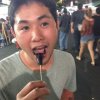
Beautiful raised-floor building in the South Village.

Minami-no-mura (South Village): This is the area where ordinary people called "geko" lived.
![The South Village contains 27 reconstructed buildings, including pit dwellings and raised-floor buildings.]()
The South Village contains 27 reconstructed buildings, including pit dwellings and raised-floor buildings.
![Entrance of a pit dwelling at Minami-no-mura]()
Entrance of a pit dwelling at Minami-no-mura
![The inside of a typical pit dwelling at Minami-no-mura]()
The inside of a typical pit dwelling at Minami-no-mura
![Another pretty raised-floor building at Minami-no-mura.]()
Another pretty raised-floor building at Minami-no-mura.
![As well as agricultural work, the extended family that lived in South Village wove hemp cloth and silk.]()
As well as agricultural work, the extended family that lived in South Village wove hemp cloth and silk.
![Kuratoichi: This area is believed to have been Yoshinogari's commercial center, featuring a large market and storehouses for trade goods.]()
Kuratoichi: This area is believed to have been Yoshinogari's commercial center, featuring a large market and storehouses for trade goods.
![Market Turret at Kuratoichi: This building is the administration office for the market.]()
Market Turret at Kuratoichi: This building is the administration office for the market.
![Views from the Market Turret's top floor.]()
Views from the Market Turret's top floor.
![Storehouses for rice and weapons at Kuratoichi.]()
Storehouses for rice and weapons at Kuratoichi.
![Entrance gate to Minami-naikaku (Southern Inner Enclosure): This is thought to have been where successive rulers of Yoshinogari resided.]()
Entrance gate to Minami-naikaku (Southern Inner Enclosure): This is thought to have been where successive rulers of Yoshinogari resided.
![The King's House at Minami-naikaku: In this enclosure 20 buildings, including 4 watchtowers, the king's house, a cooking house and the royal residences, have been reconstructed.]()
The King's House at Minami-naikaku: In this enclosure 20 buildings, including 4 watchtowers, the king's house, a cooking house and the royal residences, have been reconstructed.
![Ancestral spiritual pillar: It is assumed that the spirits of the ancestors who protect Kita-funkyubo (Northern Burial Mound) reside in this pillar.]()
Ancestral spiritual pillar: It is assumed that the spirits of the ancestors who protect Kita-funkyubo (Northern Burial Mound) reside in this pillar.
![Kita-funkyubo: This is thought to have been a special burial site where successive rulers of Yoshinogari were laid to rest.]()
Kita-funkyubo: This is thought to have been a special burial site where successive rulers of Yoshinogari were laid to rest.
![Burial procedure recreation: This type of burial method using jars has been frequently discovered in northern Kyushu, especially in Saga and Fukuoka, and it is a particularly distinctive method.]()
Burial procedure recreation: This type of burial method using jars has been frequently discovered in northern Kyushu, especially in Saga and Fukuoka, and it is a particularly distinctive method.
![Display of a genuine burial jar at Kita-funkyubo.]()
Display of a genuine burial jar at Kita-funkyubo.
![Burial jar rows for the burials of ordinary people in the Middle Yayoi period]()
Burial jar rows for the burials of ordinary people in the Middle Yayoi period
![Kita-naikaku (North Inner Enclosure): The most important and most sacred of places within the Yoshinogari settlement; nine structures have been recreated, including an enormous shrine.]()
Kita-naikaku (North Inner Enclosure): The most important and most sacred of places within the Yoshinogari settlement; nine structures have been recreated, including an enormous shrine.
![Ceremonial Hall at Kita-naikaku: This is thought to have been the center for ceremonies and festivals.]()
Ceremonial Hall at Kita-naikaku: This is thought to have been the center for ceremonies and festivals.




































































